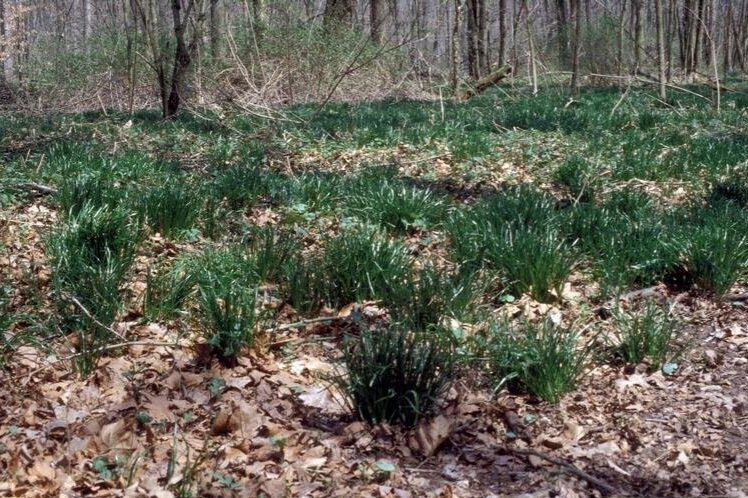March 2021 Invasive Plant of the Month
SICIM Email
Star of Bethlehem (Ornithogalum umbellatum)
Also known as Garden or Common star of Bethlehem, grass lily, nap-at-noon, eleven-o'clock lady, and sleepydick, Star of Bethlehem (Ornithogalum umbellatum) is an herbaceous perennial plant that invades disturbed areas, meadows, cemetery prairies and sunny to semi-shaded banks of streams and drainage ditches, displacing native species and invading high-quality natural habitats. Star of Bethlehem is native to most of southern and central Europe, north-western Africa and south-western Asia, and was first introduced into the US as an ornamental plant. This species has been reported escaping into natural areas in all 92 counties of Indiana.
IDENTIFICATION & BIOLOGY: Star of Bethlehem is an herbaceous plant in the lily family (Liliaceae) that grows from bulbs with annual renewal. The white bulbs are ovoid in shape and measure 0.5-1.5 inches in length. The basal leaves are shiny, dark green in color, narrow and linear with distinct white midrib that are hollow in a cross-section. White flowers with 6 petals that resemble a star occur at the ends of hairless flowering stems (scapes) and can grow up to 1 ft. in height but are normally shorter. The umbel-like raceme contains 3-10 flowers and seed pods are a 3-lobed capsule containing several oval black seeds. It blooms from May to June with flowers opening in the morning and closing at noon. The bulbs are toxic, containing glycosides similar to Digitalis, which can cause shortness of breath, skin irritation and severe swelling, and has been known to poison livestock. The foliage dies back in summer as the plant go dormant.
LOOK-A-LIKES: Star of Bethlehem resembles wild garlic (Nothoscordum bivalve), wild onion (Allium spp.), and spring beauty (Claytonia virginica) when emerging in spring, but lacks the odor of wild garlic and onion. Another similar species, nodding star of Bethlehem (Ornithogalum nutans) is also a non-native and has been known to escape cultivation.
HABITAT & DISTRIBUTION: Star of Bethlehem prefers full sun to semi-shade in fertile loam soil and moist to mesic conditions. It can be found along the banks of rivers and streams, disturbed habitats, early succession forest, forest edge, floodplain forest, wet meadows, yards and gardens. It has been reported in every county of Indiana and in many Eastern and Midwestern states, as well as California and a few other Western states.
ECOLOGICAL THREAT: Star of Bethlehem causes potential threats to native vegetation by escaping cultivation and spreading rapidly, invading high-quality natural habitats, which can put pressure on and displace native species.
CONTROL:
Prevention – The first priority to limit the spread of this invader is to stop the use of Star of Bethlehem in ornamental landscape plantings and remove it from any existing intentional plantings.
Manual – Bulbs can be dug out as the plant emerges in spring. It is imperative that all bulbs are removed and disposed of. When digging it is important to avoid leaving any bulbs or bulblets in the ground. Any dirt that is removed along with root parts should not be put back into unaffected areas since any missed bulb can give rise to a new population.
Chemical – Star-of Bethlehem is non-responsive to several herbicides. Research studies at Purdue University found that Paraquat provided 70 to 78% control.
IMPORTANT: The pesticide label is the law! When using any chemical control, always read the entire pesticide label carefully, follow all mixing and application instructions and use all personal protective gear and clothing specified. Contact the Office of Indiana State Chemist (OISC) for additional pesticide use requirements, restrictions or recommendations.
Maintenance – Initial control efforts should be monitored regularly over the course of multiple years such that continued chemical and/or cultural control of persistent or new infestations may be required.
REFERENCES & OTHER RESOURCES:
https://www.inaturalist.org/taxa/56137-Ornithogalum-umbellatum
https://www.illinoiswildflowers.info/weeds/plants/starbeth.htm
https://www.invasive.org/gist/products/handbook/methods-handbook.pdf
https://www.misin.msu.edu/facts/detail/?project=misin&id=428&cname=Star+of+Bethlehem
https://www.invasive.org/weedcd/pdfs/wow/star-of-bethlehem.pdf
https://www.invasive.org/alien/pubs/midatlantic/ornu-orum.htm
LOOK-A-LIKE REFERENCES:
https://www.illinoiswildflowers.info/prairie/plantx/false_garlic.html
https://www.invasive.org/alien/pubs/midatlantic/ornu-orum.htm
https://www.illinoiswildflowers.info/woodland/plants/spring_beauty.htm
#StarOfBethlehem #Ornithogalumumbellatum #indianainvasiveplants #indianainvasviesinitiative





